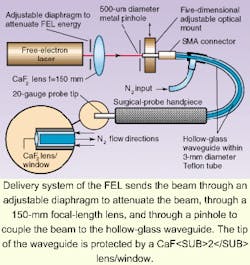Eye surgery application demonstrated with FEL

Using the Mark-III free-electron laser (FEL) at Vanderbilt University (Nashville, TN), a multicollege team of scientists has created and demonstrated a promising waveguide delivery system for microsurgical procedures. Previous studies using the tunable infrared (IR) FEL identified several optimal wavelengths for laser-tissue applications, such as 6.45 µm for laser ablation of the retina.1 Until now, however, practical use of the FEL was limited by lack of an appropriate waveguide and delivery system. Jin Shen, Karen Joos, and Duco Jansen of Vanderbilt University, along with researchers at Rutgers University (Piscataway, NJ) and Duke University (Durham, NC), have designed a device based on a hollow-glass waveguide (HGW) that can deliver FEL energy for several microsurgical applications.2
Hollow waveguides are one of the most attractive means of delivering the output from erbium:YAG and carbon dioxide lasers, due to low loss and a high-spatial-purity beam profile. The structure of a typical HGW consists of an inner metallic gold (Ag) film and a single dielectric protectant film of gold iodide (AgI), which is formed by flowing iodine solution inside the tubing. By adjusting the thickness of the AgI film, the waveguide can be optimized for a specific wavelength.
In the experiment, the team used a 2-m-long hollow waveguide with an inner diameter of 530 µm, optimized for transmission at 6 µm (see figure). The FEL beam had a single-mode Gaussian distribution with a spot size of 10 mm in diameter. A calcium fluoride (CaF2) lens was used to focus the FEL beam into a 550-µm diameter spot. An adjustable diaphragm was used to attenuate and adjust the FEL energy. A 500-µm-diameter metal pinhole at the entrance of the waveguide protected the edges from laser-induced plasma damage. The waveguide was protected further by Teflon tubing, through which nitrogen (N2) gas was circulated.
Results of open-sky retinotomies on cadaver eyes demonstrated a cutting threshold at a fluence of about 1.8 J/cm2. A practical rate of tissue removal with an acceptable optical cavitation effect was achieved at a fluence of 2.0 to 3.5 J/cm2. Higher fluence caused vaporization with adverse mechanical effects. After several trials, the surgeon determined an optimal focal distance of 2 mm. The system delivered as much as 6 x 105 W of FEL peak power to the intraocular tissues without damage to the waveguide or surgical probe.
The main advantage of the FEL, says the team, is tunability to specific absorption bands of tissue in the mid-IR spectrum range. Using the HGW, the delivery system provides effective coupling of the FEL beam, flexibility, and ease of use in microsurgical procedures—in all, a promising, feasible solution for medical beam delivery.
Shen reports that the FEL has recently been used in human trials, and he has plans to commercialize the probe.
REFERENCE
- G. S. Edwards et al., Nature, 371, 416 (1994).
- J. H. Shen, J. A. Harrington, G. S. Edwards, and K. M. Joos, Appl. Opt., 40, 583 (2001).

Valerie Coffey-Rosich | Contributing Editor
Valerie Coffey-Rosich is a freelance science and technology writer and editor and a contributing editor for Laser Focus World; she previously served as an Associate Technical Editor (2000-2003) and a Senior Technical Editor (2007-2008) for Laser Focus World.
Valerie holds a BS in physics from the University of Nevada, Reno, and an MA in astronomy from Boston University. She specializes in editing and writing about optics, photonics, astronomy, and physics in academic, reference, and business-to-business publications. In addition to Laser Focus World, her work has appeared online and in print for clients such as the American Institute of Physics, American Heritage Dictionary, BioPhotonics, Encyclopedia Britannica, EuroPhotonics, the Optical Society of America, Photonics Focus, Photonics Spectra, Sky & Telescope, and many others. She is based in Palm Springs, California.